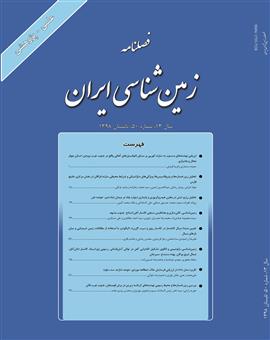زمینشناسی، کانی سازی و مغناطیس سنجی کانسار آهن استاج – جنوب مشهد
محورهای موضوعی :
کلید واژه: کانی سازی گوتیت مگنتیت هیدروترمال ناهنجاری,
چکیده مقاله :
کانی سازی آهن استاج در 40 کیلومتری جنوب شهر مشهد قرار دارد. واحدهای سنگی منطقه شامل ماسهسنگ و کوارتزیت کامبرین، آهکهای دونین، میکاشیست سیلورین و گابرو دیوریت می باشد. کانه زایی آهن هماتیتی درون سنگ میزبان: شیست و آهکی و به مقدار محدودی واحد کوارتزیت قرار دارد. کانه زایی طی دو مرحله هیپوژن (شامل کانیهای اولیه هماتیت، پیریت، مگنتیت) و اکسیدان (شامل کانیهای گوتیت، هماتیت و لیمونیت) انجام شده است. برداشتهای مغناطیس سنجی زمینی بر روی رخنمون اصلی کانی سازی هماتیتی بهمنظور بررسی عمقی کانی سازی مگنتیت انجام شد. نقشههای مغناطیسی ناهنجاریهای A و B را در محل کانی سازی اصلی و ناهنجاریهای C،D وE را در روی توده نفوذی دارد. کانی سازی کوچکی در امتداد گسل تقریبا شرقی _ غربی رخنمون دارد که با ناهنجاریهای C،D وE هممکان است. پذیرفتاری مغناطیسی نمونههای سطحی توده نفوذی و میزبان کوارتزیتی (به ترتیب SI 5-10×42 و SI 5-10×0) پایین است. در نتیجه منبع ایجادکننده ناهنجاریها در محل کانی سازی اصلی (با پذیرفتاری SI 5-10×2939-8) احتمالا مگنتیت و در محل توده نفوذی یا مگنتیت و یا توده نفوذی با پذیرفتاری بالاتر در عمق است که تایید آن نیاز به حفاری دارد.
Estaj iron deposit (EID) is located 40 km south of Mashhad. Rock units in the area include sandstone and quartzite (Cambrian), limestone (Devonian), micaschist (Silurian) and gabbro diorite. Hematite iron mineralization occured in the schist and limestone host rocks and sporadically in quartzite. Mineralization accomplished in two stages, of hypogene (including primary minerals of hematite, pyrite, and magnetite) and oxidized (including minerals, of goethite, hematite and limonite). Ground magnetic survey over main outcrop of hematite iron mineralization was carried out to investigate magnetite mineralization at depth. Magnetic maps show anomalies A and B over the main mineralization and C, D and E over the intrusive body. Small amount of mineralization is roughly cropped out along a fault with an east-west trend, coinciding with the anomalies C, D and E. Magnetic susceptibility of surface samples of intrusive body and host quartzite (〖42×10〗^(-5) SI and 〖 0×10〗^(-5) SI respectivly) is low. Consequently the main source of anomalies at the location of main mineralization (with suseptibility of 〖 8-2939×10〗^(-5) SI) is probably magnetite. In the location of intrusive body the source is either magnetite or the intrusive, body which has higher magnetite suseptibility at depth. The latter point should be verified by drilling.
آقا نباتی، س. ع.، 1383. زمینشناسی ایران. انتشارات سازمان زمینشناسی و اکتشافات معدنی کشور، 586.
-حیدریان شهری، م. ر.، 1385. مبانی اکتشافات ژئوفیزیک، چاپ دانشگاه فردوسی مشهد، 750.
-شهاب پور، ج.، 1387. زمینشناسی اقتصادی. انتشارات دانشگاه شهید باهنر کرمان، 543.
-طاهری، ج. و قائمی، ف.، 1994. نقشه 1:100000 زمینشناسی مشهد.
-کریم پور، م. ح.، ملکزاده شفارودی، آ. و حیدریان شهری، م.، 1384. اکتشاف ذخایر معدنی، انتشارات دانشگاه فردوسی مشهد، 636.
-مجیدی، ب. و علوی تهرانی، ن.، 1365. نقشه 1:250000 زمینشناسی مشهد.
-Brookins, D. G., 1988. Eh-Ph diagram for Geochemistry, Springer- Verlag, Berlin Hedelberg, 176.
-Chavez, W, X., 2000. Supergene oxidation of copper deposite: zoning and distribution of copper oxide minerals. Social Economic Geology News, 141, 10-21.
-Cooper G.R. and Cowan D.R., 2004. "Filtering using variable order vertical derivative Computer and Geosciences",. 2004. 455-459.
-Ford, K., Keating, P. and Thomas, M. D., "Overview of geophysical signature Associated with canad ian or Deposits", Geological Survey of Canada, 601 Booth Street, Ottawa, Ontario, KIA0ES 2004.
-Clark D.A., 1997, Magnetic petro physics and magnetic petrology: aids to geological interpretation of magnetic surveys AGSO journal of Australian Geology and Geophysics, 17, 2, 83.
-Guilbert, J.M. and Park, Jr. C. F., 1997. The Geology of Ore Deposits, Freaman and company, New York, 985.
-Gunn P. J and Dentith M.C., 1997. "Magnetic responses associated with mineral deposits": AGSO Journal of Australian Geology and Geophysics,. 17, 2. 145-158.
-Guun, P.J., Madment, D., and Miligan, P.R, 1997, Interpretation of aeromagnetic data in area of limited outcrop: AGSO journal of Australian Geology and Geophysics,.17, 2. 175-185.
-Ishihara, S., 1977. The magnetite-series and ilmenite –series granitic rocks. Mining geology japan 27, 243-300.
-Jaques, A.L., Wellman, P. Whitaker, A. and Wyborn, D., 1997. High- resolution geophysics in modern geological mapping. AGSO Journal of Australian Geology and Geophysics, 17, 159-173
-Liu, S. and Macky, T., 1998. Using images in a geological interpretation if magnetic data: AGSO Research Newsletter 28.
-Nabighian, M. N., Grauch, V. J. S., Hansen, R. O., Lafehr, T. R., Li, Y., Peirce, J.w., Phillips, J. D. and Ruder, M. E., 2005. The historical development of the magnetic method in exploration. Geophysics, 70, 33-61.
-Ramdhor, P., 1980. The ore minerals and their intergrowth, Pergamon Press, 1267.
-Shelley, D., 1993. Igneous and Metamorphic Rocks under the Microscope, Chapma and Hall, New York, 445.
-Richardson, L.M., Wynne, Ph. and Hone, I., 2002. Geophysical Data Sets Over Continental Australia. Preview (ASEG), 100, 48-54.
-Shervais J.W., 1982, Ti-V plots and the petrogenesis of modern and ophiolitic lavas earth planet. Sci Lett., 59, 101-118.
-Urquhart, W. E. S., 2007. Geophysical Airborne Survey Complication and Interpretation: www.geoxplo.com.

